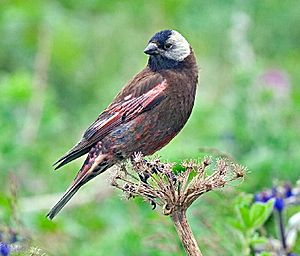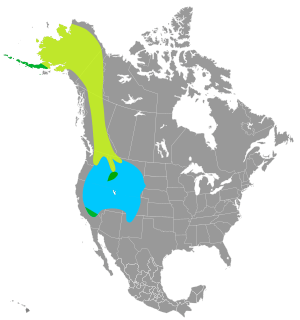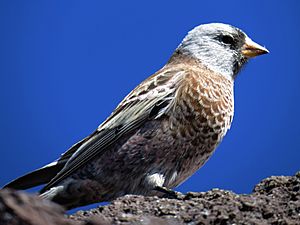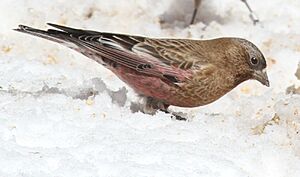Gray-crowned rosy finch facts for kids
Quick facts for kids Gray-crowned rosy finch |
|
|---|---|
 |
|
| Conservation status | |
| Scientific classification | |
| Genus: |
Leucosticte
|
| Species: |
tephrocotis
|
 |
|
| Synonyms | |
|
Linaria tephrocotis Swainson, 1831 |
|
The gray-crowned rosy finch (Leucosticte tephrocotis) is a small bird that belongs to the finch family. These birds live in cold, rocky mountain areas. You can find them in Alaska, western Canada, and the northwestern United States. Because they live in remote, high-altitude places, people don't see them very often. There are six different types, or subspecies, of the gray-crowned rosy finch. It is one of four kinds of rosy finches found around the world.
Contents
About the Gray-Crowned Rosy Finch
The gray-crowned rosy finch was first described by an English bird expert, William Swainson, in 1832. This bird is closely related to three other rosy finches in North America: the black rosy finch, the brown-capped rosy finch, and the Asian rosy finch. Scientists once thought they were all the same species. However, DNA studies show they are all very close relatives. These North American rosy finches, along with some Asian mountain finches, belong to a group called Leucosticte.
Other names for this bird in different languages include:
- Roselin à tête grise (French)
- Schwarzstirn-Schneegimpel (German)
- Pinzón Montano Nuquigrís (Spanish)
Different Kinds of Rosy Finches
There are six recognized subspecies of the gray-crowned rosy finch. Each one lives in a slightly different area:
- L. t. griseonucha: Found on Commander Island and the Aleutian Islands in Alaska.
- L. t. umbrina: Lives on Hall Island, St. Matthew Island, and the Pribilof Islands in the Bering Sea.
- L. t. littoralis: Also called "Hepburn’s rosy-finch." It breeds from south-central Alaska down to northern California. In winter, it flies south to places like Montana and New Mexico.
- L. t. tephrocotis: Also known as "brown-cheeked rosy-finch." It breeds in northern Alaska and western Canada. In winter, it moves south to places like California and Colorado.
- L. t. wallowa: Breeds in the Wallowa Mountains of northeast Oregon. It winters in Nevada and California.
- L. t. dawsoni: Found in eastern California, especially in the Sierra Nevada mountains.
What Does the Rosy Finch Look Like?

The gray-crowned rosy finch is a medium-sized bird in the finch family. It has a fairly long, forked tail and medium-sized wings.
Adult birds have brown backs and chests. Their bellies and parts of their wings are mostly pink. They have a black forehead and throat, with a gray area on the back of their head. Their legs are short and black. The amount of gray on their head can vary. Young birds and adult females look similar to each other.
These birds are about 14 to 16 centimeters (5.5 to 6.3 inches) long. Their wingspan is about 33 centimeters (13 inches). They weigh between 22 and 60 grams (0.8 to 2.1 ounces). The subspecies living on the Pribilof and Aleutian Islands are larger. They can be up to 21 centimeters (8.3 inches) long and weigh up to 60 grams.
You can tell them apart from other rosy finches. The black rosy finch has a black body instead of brown. The brown-capped rosy finch is a lighter brown and does not have the gray patch on its face.
Where Rosy Finches Live
The ancestors of the North American rosy finches came from Asia. All rosy finches prefer to live in very cold, high-altitude places like mountains or tundra. The gray-crowned rosy finch lives across a wide area. This includes Alaska, western Canada, and the western United States.
Some subspecies, like L. t. griseonucha and umbrina, live in the Aleutian and Pribilof Islands all year round. Other types, like littoralis and tephrocotis, live in the Rocky Mountains. They fly south for the winter.
Because these birds live in such remote places, their nests are hard to find. They are not often seen by people. Their population is currently stable, meaning their numbers are not decreasing. They are almost always found among rocks. During breeding season, different subspecies usually stay in their own areas. Male rosy finches often outnumber females throughout the year.
Rosy Finch Behavior and Life Cycle
Rosy finches are very particular about their environment. In the summer, they breed in rocky islands and bare mountain areas. These places often have snowfields and loose rocks.
When it's not breeding season, they gather in large groups. These flocks can have over 1,000 birds! Sometimes, other birds like snow buntings and horned larks join them. As the snow gets deeper in autumn, they fly down to lower areas. They return to the high mountains in early spring, even when there's still a lot of snow.
These birds might breed at higher altitudes than any other bird in North America. This makes them very hard to watch during breeding time.
Nesting and Young Birds
Rosy finches build a cup-shaped nest in mid-June. They choose a hidden, sheltered spot on the ground or on a cliff. They are monogamous, meaning one male and one female stay together. They sometimes use old mine shafts or abandoned buildings for nesting.
Both the male and female collect materials for the nest, like grass, roots, and moss. But only the female builds the nest. She lines it with soft materials like fine grass, hair, and feathers. The female lays 3 to 5 eggs and sits on them for about two weeks. Both parents feed the chicks. The young birds leave the nest after 2 to 3 weeks. They continue to be fed by their parents for about two more weeks, usually until late July or early August. During breeding season, the male will protect the female's territory, not just the nest.
What Rosy Finches Eat
These birds look for food on the ground. Many also fly to catch insects in the air. In the summer, they mostly eat insects. They especially like cutworms that get caught in updrafts and freeze in snowfields. They also find food in meadows near the snow.
In winter, they eat seeds from weeds and grasses. This includes plants like Russian thistle, mustard, and sunflowers. When they are breeding, both male and female rosy finches develop special throat pouches. These pouches help them carry food back to their chicks. This is a rare feature in North American birds.
The rosy finches that live in the mountains have brown cheeks instead of gray ones. These birds are not very afraid of humans. They often feed in small groups. Their call sounds like a buzzing "chew." You can often get quite close to them, sometimes within 1 to 2 meters (3 to 6 feet).
See also
 In Spanish: Pinzón montano nuquigrís para niños
In Spanish: Pinzón montano nuquigrís para niños



